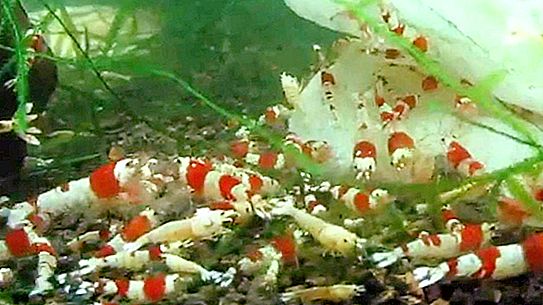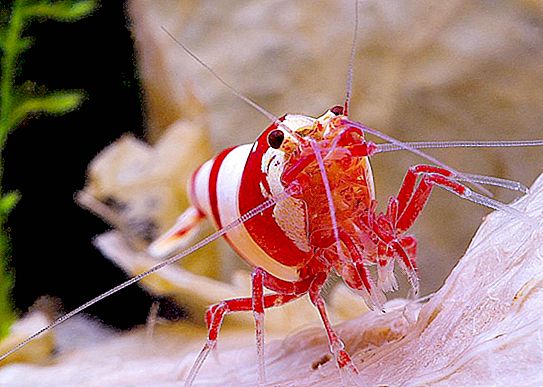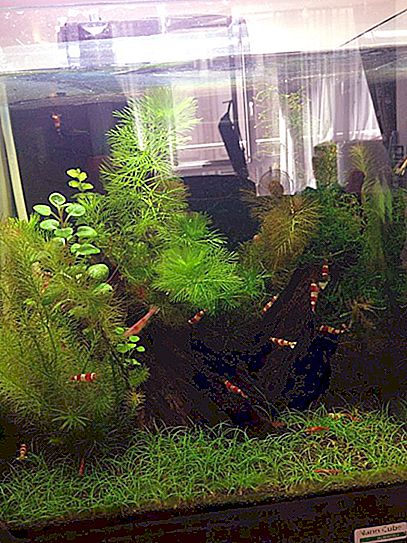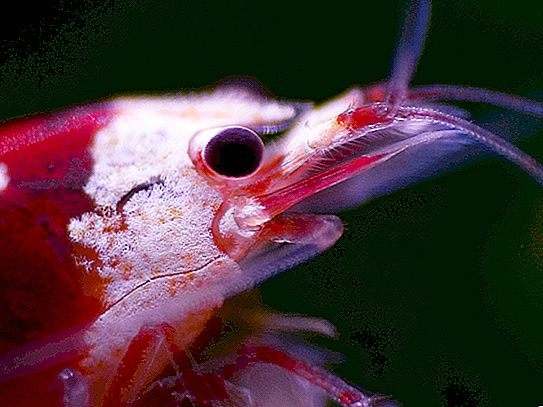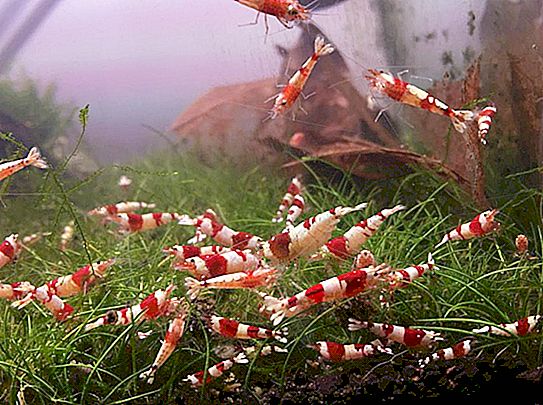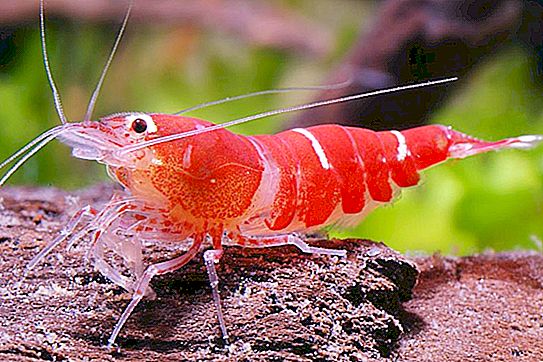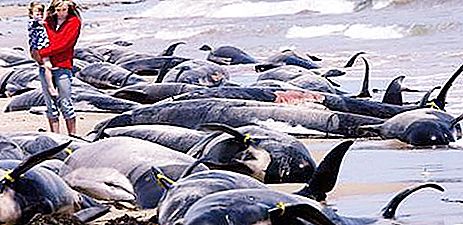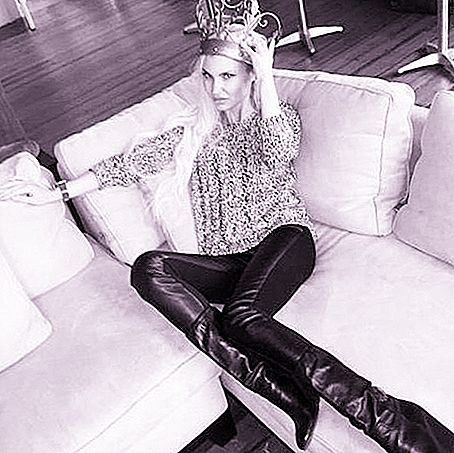A special caste of aquarists are those who become the owner of a red clearing of Red crystals. These are not precious stones, but amazing crustaceans from the category of shrimp. These amazing creatures called the Red Crystal, scurrying in an aquarium, not only fascinate, but also become a source of pride. What are the features of shrimp content - this is discussed in this article.
Caridina cantonensis
This is the name that all the subtypes of decapod crustaceans that are found in aquariums have, and are called crystals or bees. The main feature of this species is the contrasting stripes that adorn the body of the shrimp. These aquarium inhabitants live from 2 to 6 years, females can grow up to 3 centimeters, males are slightly smaller in size. Coloring (and they can be white, with black and red stripes) depends not only on the conditions of detention, but even on the mood and environment of the crustaceans. That is why professionals who are experienced in this business become shrimp aquarists.
So different
In nature, shrimp of this species live in freshwater bodies of Southeast Asia and have exclusively black stripes on their bodies. But in artificial conditions, subtypes of exceptional beauty are derived:
- White or gold crystals - shrimp with a red-orange body and decorated with rich white shell.
- Black crystals differ from natural counterparts in a brighter color intensity of the stripes.
- Red crystals are the most popular subspecies of aquarium crustaceans. They are bred artificially, therefore, are not found in the wild. We will talk about them in this article.
Shrimp Red Crystal
Once, in 1996, an experienced aquarist from Japan Hisayasu Suzuki saw several shrimp with an amazing mutation in the offspring of their Black crystals. These individuals had red streaks caused by a mutation in the color gene. It was these accidentally mutated crustaceans that became the progenitors of a new breed of unique aquarium inhabitants. Red crystals quickly gained popularity and became a source of pride - because their color is unique, and it is quite difficult to breed an individual with beautiful white stripes or a unique pattern of red stripes.
Strict beauty standards
Today, Red Crystals is an exhibition form. In the world exhibitions and competitions are held to determine the most unique shrimp and they are not cheap. The most stringent standards have been developed for Red Crystal shrimp - Japanese (classes C, B, A, S, S +, SSS) and German (classes K0 – K14). All of them are based on the quality of uniformity of color, clarity of boundaries, the predominance of red or white.
The red crystal of the lowest class (C and K0) has not clear boundaries of wide red stripes. The more white the shrimp is and the finer the strip of red, the higher its class. Red crystals of the highest rank are dominated by a white tint, and red spots are present in minimal quantities and have unique outlines. These individuals are especially appreciated by professionals and often have their own names. For example, “White Fang” or “Crown”. But it is worth remembering that the color can change and therefore the conditions for keeping Red Crystal shrimp come to the fore.
Demanding and clean
And in nature, shrimp live mainly in clean water with a stable chemical composition, and even legends go about the content of Red crystals. Only an experienced aquarist can create optimal conditions for a comfortable stay and reproduction of these decapod crayfish.
The smallest changes in the environment and these shrimps will turn pale at best, and perish at worst. At the same time, the higher the individual is, the more demanding it is to living conditions.
House for "jewelry"
The aquarium for Red crystals - shrimp - can be small (10-20 liters) if 4-6 individuals live in it. There is evidence that the minimum volume for 1 shrimp should be about 1 liter. However, much depends on the vegetation and scenery. Shrimp is preferable to choose not high, but with a large area of the bottom surface. If you want crystals to multiply, then the aquarium should be at least 50 liters in volume.
Another important fact is that many diseases and the death of crustaceans can be triggered by overpopulation. Therefore, it is exclusively by trial and error and replanting the young that the optimum bio-balance in the aquarium is achieved.
Water - Crystal Habitat
The most significant factor for the normal functioning of crystals is the composition of water and the stability of its parameters.
The upper classes of shrimp will die with a water hardness of 4 mEq / l, although the lower ones will also increase this indicator to 13. The optimum water hardness in the shrimp is from 3 to 5 mEq / l, which can be achieved by mixing tap water with water osmotic treatment.
The temperature regime is also quite tough - from 21 to 23 degrees. In this case, if the mark of the thermometer drops to 16 or rises to 26 degrees - the shrimp will die.
Powerful water filters and aerators are a must. After all, these animals are very sensitive to metabolites, ammonia and nitrates. It is recommended that at least once every 10 days replace a third of the water in the aquarium.
Related requirements
The soil in the shrimp should be shallow. Suitable sand or small pebbles without sharp edges, optimally - aquasoils, which acidify and soften the water.
When choosing plants, it must be borne in mind that they must be stunted and unedged. When cutting algae, substances are released that can lead to the death of crystals. It is good to plant mosses and ferns, pistols and carpet algae, hornwort and liverwort in the shrimp farmer. You can place and floating forms. Categorically contraindicated for the life of shrimp anubias and cryptocrines.
These moving crustaceans love shelters, so you can decorate the aquarium with snags and large stones.
The crystals do not require special lighting, but they look beautiful if there is one.
Nutrition is the foundation of crystal well-being
Shrimps are omnivores and that is why if there is vegetation in the aquarium they will not be hungry. But the nature of nutrition is directly related not so much to life as to the nature of color, which is very important for Red crystals. Poor and varied nutrition leads to a loss of bright white color.
There are many ready-made granular feeds for shrimp, which already include minerals and iron, so important for the contrast of color and the formation of the shell (Crustamenu TETRA, NovoPrawn JBL, ShrimpsNatural SERA, CrustaGran Dennerle). In addition, crustaceans do not disdain Cyclops and Daphnia, slices of fruits and vegetables. They will eat the leaves of apple and mulberry, spinach and Indian almonds. Snag willow or alder will be an excellent food for crystals.
The main thing in feeding is not to overdo it. The main food should be eaten by shrimp within an hour. It is useful to arrange unloading for two or three days - in which case they will eat up everything they find in the aquarium.
Breeding
Do you expect offspring from crystals? In general, this is not an idle question. And even if the crystals are good, it is not a fact that they will multiply. There are several nuances:
- Firstly, the temperature regime. At optimal temperatures in the aquarium, they will multiply and will not think. In nature, shrimp breeding is associated with the rainy season and therefore, a signal for reproductive behavior for crustaceans will be a decrease in temperature by 1-2 degrees, which will provoke molting. In this case, the males will attend to the search for the female, quickly fertilize the eggs and lose interest in her. But to care for the eggs that are on the reproductive limbs of the abdomen, the female will shake them and aerate. After 20-30 days, small copies of adult shrimp will appear from the eggs, which will immediately begin an independent life.
- Secondly, shrimp are capable of breeding at the age of six months. But if it has not grown to 2 centimeters, then it is not capable of reproduction.
- Thirdly, although shrimps do not eat their offspring, it is advisable to plant females with caviar in an aquarium with silty soil and many shelters for breeding. Small crustaceans are very vulnerable creatures and require very high environmental stability. They do not need any additional feeding.
